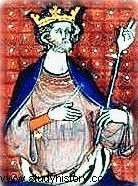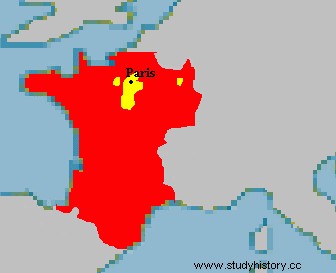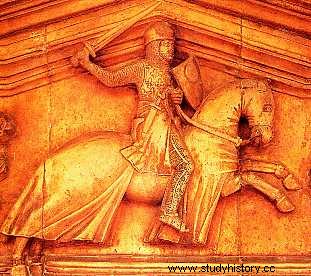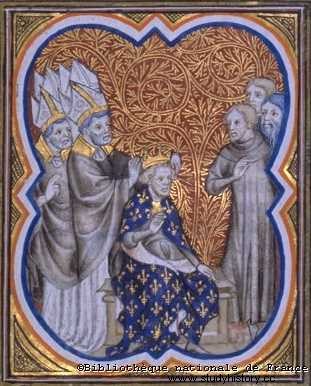Intro
After the Treaty of Verdun, the Carolingians reigned over West Francia, but real power increasingly eluded them, as powerful lords reinforced theirs over their fiefs. The Robertians, Counts of Paris then disputed the crown with the Carolingians. Soon this powerful family would obtain royal power and establish it for almost 800 years. This period is also marked by the rise of the Duchy of Normandy, land allocated to the Viking invaders. The increasingly powerful Dukes of Normandy would conquer Great Britain, provoking an almost permanent conflict between France and England.
The end of a dynasty
The Last Carolingians
In France, the multiple invasions of the Scandinavians and the Hungarians had considerably weakened the country. The devastation of the regions led them to withdraw into themselves. Feudalism brought about a hierarchy on several levels. A lord ensured the security of his lands, these lands being divided into fiefs assigned to a vassal. Feudalism thus led to an important localization so that there was no longer really a Nation, but rather a magma of regions led by dukes or counts, vassals of the king of France. These dukes had made their fiefs a family heirloom. In 954, Lothair, son of Louis IV, became king of France. The death in 956 of Hugh the Great, the powerful Count of Paris, will favor the beginning of his reign. But the young Hugues Capet, son of Hugues le Grand wanted to keep his family advantages. However the conflict which opposes him to Lothaire seems to turn in favor of the Carolingian king. But Lothaire will get bogged down in a conflict with Otton, the emperor of Germany, at the end of his reign the king is very weakened. His son, Louis V was already associated with the throne alongside his father. On the death of Lothair, Louis was therefore already king, but his situation was extremely precarious. He had to face the Duke of the Franks, Hugues Capet, who had the support of the Archbishop of Reims, Adalbéron. The support of the Church of Reims is important because it is she who ensures the legitimacy of the King of France, the same who baptized Clovis. But in 987, Louis V died suddenly in a hunting accident, he then had no direct heir.
Hugues Capet
It was not until the 12th century that Hugues was nicknamed Capet, no doubt because, like his ancestors, he was abbot of Tours, where a fragment of Saint Martin's coat (capa) was kept. At this time we became aware of the political turning point of 987 with the emergence of a new dynasty which continued until 1792, and was restored from 1815 to 1848. In 1792, when Louis XVI was tried, he called himself under the nickname of Louis Capet, in reference to the name of his ancestor.

The election of Hugues Capet
On the death of Louis V, only his uncle Charles, Duke of Lorraine, claimed the right to the crown as a descendant of the Carolingians. But Hugues Capet, then Count of Paris, Senlis, Orléans and Dreux, then played on his relations with the powerful prelate Adalbéron. He took advantage of this circumstance to have himself elected king by an assembly of lords who allowed themselves to be convinced by the archbishop with these words:“We are not unaware that Charles of Lorraine has supporters:they claim that the throne belongs to him by birthright. If the question is asked, we will answer that the throne is not acquired by hereditary right. Only he should be brought up there who is distinguished not only by bodily nobility, but also by the wisdom which finds its natural support in his loyalty...” Thus, on July 3, 987, Hugues Capet was crowned king in the cathedral of Noyon by Archbishop Adalbéron. On Christmas Day of the same year, Hugues associated his son Robert with the government and had him consecrated during his lifetime. Aware of the fragility of his ascent, he thus ensured the inheritance of the kingdom to his son. A clever process which made it possible to substitute the elective monarchy desired by the Great and in force under the last Carolingians, with a hereditary monarchy, a guarantee of continuity. The Capetians reigned in France until 1848, with the only interruption being the French Revolution and the arrival of Napoleon.
The coronation ritual
Like the Carolingians, the Capetians used religious prestige to establish their legitimacy. After Hugues Capet and up to Charles X, each king had at heart to renew the ritual of the coronation. Originally the coronation is a Germanic practice inherited from the barbarians. The king acts as an intercessor between the divine world and the human world. Pepin the Short was the first to be crowned in this way in confirmation of his accession to royalty. The Capetians maintained a confusion between the Germanic coronation and the baptism of Clovis in order to root their legitimacy in the depths of history. Two characteristic relics are used during the coronation of kings:
- The sword of Charlemagne, called "Joyeuse", this sword was part with its scabbard of the Treasury of the Abbey of Saint-Denis.
- The holy oil poured on the sovereign's forehead. The Holy Ampulla which contains the oil is said to have been transmitted to Bishop Rémi by an angel and its content is miraculously regenerated with each anointing. Bishop Rémi used this oil during the baptism of Clovis.

The first Capetians
The reign of Hugues Capet
At the end of the 10th century, the King of France was one lord among many others. He is even less powerful and influential than most of his peers. In truth, he is really the master only of a region comprised between Paris and Orleans. But unlike the other lords who elected him, the new king was crowned and no one doubts that he was chosen by God to bring peace to the kingdom. The coronation of Hugh is a founding element of the modern kingdom of France. The kingdom of Hugh extends over the Paris basin, the former Merovingian Neustria. The Capétiens will make it the core of present-day France. The king must quickly impose himself on his territory against the small barons or the great vassals of the counties of Blois and Anjou. Its legitimacy is indeed very fragile. When he opposes his vassal Adalbert de Périgord, refusing to lift the siege of Tours, Hugues asks him:“Who made you count? and the vassal replied, "Who made you king?" ". At the same time, Arnoul replaced his uncle Adalbéron, at the bishopric of Reims. The latter being a supporter of the Carolingian Charles of Lorraine, it then became urgent for Hugues Capet to dismiss this dangerous suitor. Thanks to an organized betrayal, Charles is finally captured, it is the end of the Carolingian pretensions. In 996, Hugues was in Saint-Martin de Tours when he died of smallpox. He is buried in Saint-Denis.
France in the year 1000


The reign of Robert II the Pious
Robert II is educated by the famous Gerbert d'Aurillac (who will become pope under the name of Sylvester II). He retained a great piety from this education, hence his nickname. Like all his contemporaries, he passed the year 1000 without realizing it. He marries Rozzala, the widow of the Count of Flanders, 35 years his senior, but she brings him an interesting dowry. Despite his piety, Robert is excommunicated for having divorced his wife. Robert's reign is marked by the acquisition of Burgundy after 12 years of conflict. The duchy is given to his son Henri, who will soon be associated with the throne as Hugues Capet had done for Robert. The great feudatories thus lose their right of election. But the young dynasty remains under the threat of the Great, the Capetian domain being tightened around a vice. In 1026, Robert's son, Henri was crowned king in Reims. Henceforth, to consolidate the position of the eldest son, it was decided that on the death of his father, he would inherit the entire royal domain and that there would be no division between him and his brothers. The Salic law used by the Merovingians and Carolingians is thus forgotten, the division of the kingdom between the sons had already caused the dislocation of the kingdom of Clovis and the dismantling of the empire of Charlemagne during the Treaty of Verdun. Thus, on the death of Robert II the Pious, Henry I had a more solid position within the kingdom.
Robert II the Pious
Robert II is the first miracle-working king. Since then, all Capetian kings will have the gift of curing scrofula (lymph node tuberculosis). Thus, after a king had touched a sick person, a spontaneous healing could be linked to the royal gesture considered as divine intervention.

The reign of Henry I
Henry is the second son of Robert II the Pious, he is associated with the throne when his elder brother dies in 1026. Having become king, Henry marries the daughter of the Emperor of Germany who will die the following year. Henri therefore marries Anne of kyiv for the second time. Their son, Philippe will be the future king, from the age of seven, he is associated with the throne. Henri's situation is quite delicate, his mother, Constance, wishes to see her third son on the throne. She finds the support of several feudatories in particular of Eudes II of Blois. Henri is forced to take refuge with the Duke of Normandy, Robert le Diable. He nevertheless has many allies:the Count of Flanders, the Count of Anjou and the Emperor of Germany, Conrad. He restored the situation by awarding Burgundy (which he had received from his father) to his half-brother. These are the various quarrels between the lords which will allow the safety of the king. In 1047, Henri won the battle of Vals les Dunes against the Norman barons who opposed the young Duke Guillaume. But soon, the king must reverse his alliance, the Norman duke having become too powerful. But William of Normandy wins a victory against the king and his allies. Henry I died in 1060, his son Philip I then succeeded him.
The Norman Conquest
The Duchy of Normandy
After the Treaty of Saint-Clair sur Epte in 911, Normandy (land of the Normans) was attributed to Rollon, a Viking chieftain. King Charles II then ensured peace with the Scandinavian invaders. The Normans had converted and they were now vassals of the King of France. The successors of Rollon took the title of counts of Normandy until Richard II where they became dukes. Normandy did not escape the process of emancipation of the territorial princes. The dukes dispense justice, strike their coins, levy taxes... But unlike other territorial princes, the Norman dukes avoid leaving excessive powers to their vassals. The duchy is one of the largest and wealthiest in the kingdom. The Frankish aristocracy mixed with a party of men of Scandinavian origin. The duchy grew over the years thanks in particular to Guillaume Longue Epée, son of Rollo. In 1028, Robert the Magnificent (or the Devil) became duke on the death of his brother. This helps King Henry I to fight against his rebellious mother and brothers. He died suddenly in Nicaea on his return from a pilgrimage to Jerusalem.
William the Conqueror

Stone from the tomb of William the Conqueror (cloister of the Church of the Annunciation, in Florence - Italy)
Guillaume "the Bastard"
Before leaving for Jerusalem, Robert the Devil appointed one of his sons, William, to succeed him. The Norman tradition wanted a man to have several wives and to be able to choose one of his sons to inherit. Arlette, Guillaume's mother was the daughter of a tanner, her modest origins earned Guillaume the nickname "Bastard". During the minority of Guillaume, the disorders multiplied in Normandy. William was still young and very often on his own when faced with the Norman barons who were trying to seize power. With the help of King Henry I, he put down the revolt of the barons in Vals les Dunes. In 1050, he married his cousin Mathilde of Flanders, unlike his father, he remained monogamous and faithful to his wife. The following years were marked by feudal conflicts, Guillaume revealing himself to be a formidable man of war. He even defeats the royal troops of Henry I. In 1066 William of Normandy became one of the most powerful men in the kingdom. He founded the city of Caen, building his castle and two abbeys (the Men's Abbey dedicated to Saint Etienne and the Ladies' Abbey dedicated to the Holy Trinity).
The conquest of England
In 1066, the King of England, Edward the Confessor died without an heir. Edward's half-brother, Harold ascends the throne forgetting a promise made a few years earlier that made William the successor of his cousin Edward. William then prepares the invasion of England. He first obtains the excommunication of Harold by the pope, because he had recognized the choice of Edward on sacred relics. Under the papal standard, William was then preparing the attack on England. Knights from all over France joined him. After crossing the Channel, he landed in Wessex. The clash of armies takes place at Hastings. Victorious, William the Conqueror was crowned King of England on Christmas Day 1066. This date is fundamental in the English monarchy. It is the end of the Saxon domination on the island. The conquest of England is told by the Bayeux tapestry, one of the artistic masterpieces of the Middle Ages (70 meters long). The origin of the tapestry remains enigmatic, legend attributes it to Queen Mathilde. Having become king, William accomplished an immense work, building numerous monuments, in particular the Tower of London. In 1085, he commissioned what can be called a census in the modern sense, the “Book of the Last Judgment” or Domesday's Book, which listed the men and wealth of the kingdom. Guillaume remains however the vassal of the weak king of France. And this will cause real conflicts between the two countries because of the English possessions on French territory. The Normans also established themselves in Sicily, where Robert Guiscard established himself in 1059, delivering the besieged Pope to Rome. Several Norman dynasties thus settled in Europe. In England, French is the language of the Court, English is in fact an amalgam between Saxon and French which represents approximately 60% of its vocabulary.
The Battle of Hastings
On October 14, 1066, Norman and Saxon troops clashed at Hastings. There are about 7,000 men in each camp. The Saxon army is very disparate and essentially made up of men on foot whose only instructions are to “bombard the enemy with all possible projectiles. The front line is protected by a belt of shields. Opposite, the army of Guillaume seems better organized. It is made up of Normans, Bretons, Flemish, French... A first line of archers is responsible for harassing the enemy while a line of infantry takes over. The knights follow... Following Guillaume's plan, the archers shoot their arrows at the opposing lines. But the Norman chivalry is scattered in the swamps, it is the rout. Rumor has it that the Duke of Normandy has been killed. Panic wins the ranks, the English set off in pursuit of the fugitives. Guillaume takes off his helmet and goes through his lines so that his soldiers recognize him. But the English defenses held firm. It was then that he ordered a mock retreat. A stroke of genius! He thus attracts the disorganized and undisciplined English to better slay them. The battle continued into the afternoon. Harold dies after being shot in the eye. By nightfall, William had won the battle of Hastings, as well as the throne of England. The papal banner raised during the battle gives the expedition the status of a true crusade against the Saxon king. Transforming the country into one of the most powerful in Europe, the Normans imported the longbow, which made its first appearance in Hastings. Favorite weapon of the English, devastating during the Hundred Years War.

Detail of the Bayeux Tapestry
The strengthening of the Capetian kings
The reign of Philip I
When King Henry I died, his son Philippe was still very young to reign. It was his uncle, the Count of Flanders, Baudouin V (father of Mathilde, wife of William the Conqueror) who ensured the regency. Philip must quickly oppose the power of William the Conqueror, who became king of England in 1066. Unable to defeat him directly, Philip then plays diplomacy, raising the sons of the English king against their father. After driving him out of Brittany, he supported Robert Courteheuse, Guillaume's son who inherited the Duchy of Normandy. As a reward, Robert Courteheuse offers him Gisors. William the Conqueror died in 1087, his other son Guillaume le Roux then succeeded him. Philippe then continues to support Robert against his brother, he intends to dissociate Normandy from England. Guillaume le Roux projects the invasion of the royal territory, it is the son of Philippe, Louis who manages to drive him out of the kingdom. In 1095, Pope Urban II launched the First Crusade, but Philip was dismissed from the expedition for having repudiated his wife, against Church law. Philippe I helped to expand the royal domain by obtaining Vermandois, French Vexin and Gatinais in particular. But the situation of the Capetian remains under the threat of the great lords of the kingdom, some do not hesitate to plunder the royal domain. Towards the end of his reign, Philippe let his son Louis govern the country. He died in 1108, after a long reign of almost 50 years.
The reign of Louis VI the Fat
After the death of Philip I, the transmission of the crown to the eldest son of the deceased king seemed to be accepted by all the Greats of the kingdom. Louis VI, as his nickname suggests, was certainly a big man, but his corpulence did not prevent him from leading the active life to which his title of king condemned him. Suger, the grand councilor of the crown, left us this striking portrait of the sovereign:"Placed between the enemy battle corps, sword in hand...he fought hand to hand, performing the office of a mere knight, not a king. » And this is how we must imagine the King of France at the beginning of the twelfth century, paying with his own person, and, if the circumstances required it, reddening his sword with the blood of his enemies. Louis le Gros first defended the kingdom against foreign companies:that of Henry I, King of England and Duke of Normandy. The war, which was turning to Henry's advantage (victory at Bremule in 1119) was interrupted after the disappearance of the English king's heirs during a shipwreck in the English Channel. Henry I then led his son-in-law Henry V against France, the German emperor who tried unsuccessfully, in 1124, to invade Champagne. But Louis spent most of his time strengthening his authority within the royal domain itself:against the looting barons who threatened the safety of church people and merchants, or against his intractable vassals or felons (traitors) , he carried the war, riding ceaselessly and fighting battle upon battle. Louis will have enlarged his domain of Auvergne, Poitou, Limousin, Périgord, Bordeaux, Agenais and Gascony. The kingdom of France was beginning to take shape.
Coronation of Louis VI the Fat, King of France
The first text referring to the word France dates back to 1119. In a letter addressed to Pope Calixte II, Louis VI declared himself king of France, no longer of the Franks, and particular son of the Roman Church.

(National Library of France)
